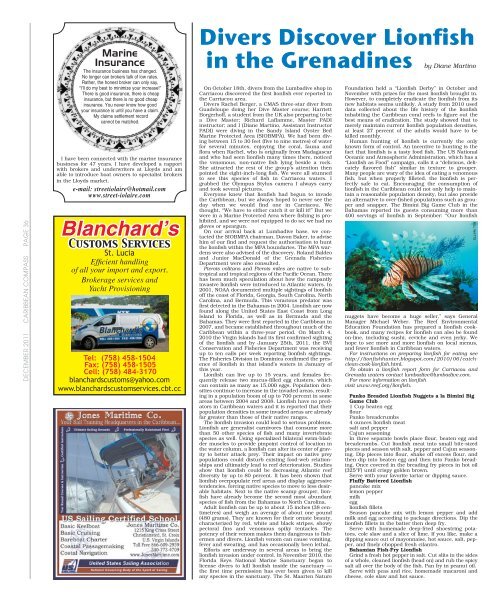do where do you want you want - Caribbean Compass
do where do you want you want - Caribbean Compass
do where do you want you want - Caribbean Compass
Create successful ePaper yourself
Turn your PDF publications into a flip-book with our unique Google optimized e-Paper software.
DECEMBER 2011 CARIBBEAN COMPASS PAGE 36<br />
Marine<br />
Insurance<br />
The insurance business has changed.<br />
No longer can brokers talk of low rates.<br />
Rather, the honest broker can only say,<br />
“I’ll <strong>do</strong> my best to minimize <strong>you</strong>r increase!”<br />
There is good insurance, there is cheap<br />
insurance, but there is no good cheap<br />
insurance. You never know how good<br />
<strong>you</strong>r insurance is until <strong>you</strong> have a claim.<br />
My claims settlement record<br />
cannot be matched.<br />
I have been connected with the marine insurance<br />
business for 47 years. I have developed a rapport<br />
with brokers and underwriters at Lloyds and am<br />
able to introduce boat owners to specialist brokers<br />
in the Lloyds market.<br />
e-mail: streetiolaire@hotmail.com<br />
www.street-iolaire.com<br />
Blanchard’s<br />
Customs Services<br />
St. Lucia<br />
Effi cient handling<br />
of all <strong>you</strong>r import and export.<br />
Brokerage services and<br />
Yacht Provisioning<br />
Tel: (758) 458-1504<br />
Fax: (758) 458-1505<br />
Cell: (758) 484-3170<br />
blanchardscustoms@yahoo.com<br />
www.blanchardscustomservices.cbt.cc<br />
Divers Discover Lionfish<br />
in the Grenadines by Diane Martino<br />
On October 18th, divers from the Lumbadive shop in<br />
Carriacou discovered the first lionfish ever reported in<br />
the Carriacou area.<br />
Divers Rachel Berger, a CMAS three-star diver from<br />
Guadeloupe <strong>do</strong>ing her Dive Master course; Harriett<br />
Borgerhoff, a student from the UK also preparing to be<br />
a Dive Master; Richard Laflamme, Master PADI<br />
instructor; and I (Diane Martino, Assistant Instructor<br />
PADI) were diving in the Sandy Island Oyster Bed<br />
Marine Protected Area (SIOBMPA). We had been diving<br />
between 15 to 30 feet (five to nine metres) of water<br />
for several minutes, enjoying the coral, fauna and<br />
flora when Rachel, who is originally from Madagascar<br />
and who had seen lionfish many times there, noticed<br />
the venomous, non-native fish lying beside a rock.<br />
She attracted the rest of the group’s attention then<br />
pointed the eight-inch-long fish. We were all stunned<br />
to see this species of fish in Carriacou waters. I<br />
grabbed the Olympus Stylus camera I always carry<br />
and took several pictures.<br />
Everyone knew that lionfish had begun to invade<br />
the <strong>Caribbean</strong>, but we always hoped to never see the<br />
day when we would find one in Carriacou. We<br />
thought, “We have to either catch it or kill it!” But we<br />
were in a Marine Protected Area <strong>where</strong> fishing is prohibited,<br />
and we were not equipped to <strong>do</strong> so; we had no<br />
gloves or speargun.<br />
On our arrival back at Lumbadive base, we contacted<br />
the SIOBMPA chairman, Davon Baker, to advise<br />
him of our find and request the authorisation to hunt<br />
the lionfish within the MPA boundaries. The MPA wardens<br />
were also advised of the discovery. Roland Baldeo<br />
and Junior MacDonald of the Grenada Fisheries<br />
Department were also consulted.<br />
Pterois volitans and Pterois miles are native to subtropical<br />
and tropical regions of the Pacific Ocean. There<br />
has been much speculation about how the rampantly<br />
invasive lionfish were introduced to Atlantic waters. In<br />
2001, NOAA <strong>do</strong>cumented multiple sightings of lionfish<br />
off the coast of Florida, Georgia, South Carolina, North<br />
Carolina, and Bermuda. This voracious predator was<br />
first detected in the Bahamas in 2004. Lionfish are now<br />
found along the United States East Coast from Long<br />
Island to Florida, as well as in Bermuda and the<br />
Bahamas. They were first reported in the <strong>Caribbean</strong> in<br />
2007, and became established throughout much of the<br />
<strong>Caribbean</strong> within a three-year period. On March 4,<br />
2010 the Virgin Islands had its first confirmed sighting<br />
of the lionfish and by January 25th, 2011, the BVI<br />
Conservation and Fisheries Department was receiving<br />
up to ten calls per week reporting lionfish sightings.<br />
The Fisheries Division in Dominica confirmed the presence<br />
of lionfish in that island’s waters in January of<br />
this year.<br />
Lionfish can live up to 15 years, and females frequently<br />
release two mucus-filled egg clusters, which<br />
can contain as many as 15,000 eggs. Population densities<br />
continue to increase in the invaded areas, resulting<br />
in a population boom of up to 700 percent in some<br />
areas between 2004 and 2008. Lionfish have no predators<br />
in <strong>Caribbean</strong> waters and it is reported that their<br />
population densities in some invaded areas are already<br />
far greater than those of their native ranges.<br />
The lionfish invasion could lead to serious problems.<br />
Lionfish are generalist carnivores that consume more<br />
than 50 other species of fish and many invertebrate<br />
species as well. Using specialized bilateral swim-bladder<br />
muscles to provide pinpoint control of location in<br />
the water column, a lionfish can alter its center of gravity<br />
to better attack prey. Their impact on native prey<br />
populations could disturb existing food-web relationships<br />
and ultimately lead to reef deterioration. Studies<br />
show that lionfish could be decreasing Atlantic reef<br />
diversity by up to 80 percent. It has been shown that<br />
lionfish overpopulate reef areas and display aggressive<br />
tendencies, forcing native species to move to less desirable<br />
habitats. Next to the native scamp grouper, lionfish<br />
have already become the second most abundant<br />
species of fish from the Bahamas to North Carolina.<br />
Adult lionfish can be up to about 15 inches (38 centimetres)<br />
and weigh an average of about one pound<br />
(480 grams). They are known for their ornate beauty,<br />
characterized by red, white and black stripes, showy<br />
pectoral fins and venomous spiky tentacles. The<br />
potency of their venom makes them dangerous to fishermen<br />
and divers. Lionfish venom can cause vomiting,<br />
fever and sweating, and has occasionally been lethal.<br />
Efforts are underway in several areas to bring the<br />
lionfish invasion under control. In November 2010, the<br />
Florida Keys National Marine Sanctuary began to<br />
license divers to kill lionfish inside the sanctuary —<br />
the first time permission has ever been given to kill<br />
any species in the sanctuary. The St. Maarten Nature<br />
Foundation held a “Lionfish Derby” in October and<br />
November with prizes for the most lionfish brought in.<br />
However, to completely eradicate the lionfish from its<br />
new habitats seems unlikely. A study from 2010 used<br />
data collected about the life history of the lionfish<br />
inhabiting the <strong>Caribbean</strong> coral reefs to figure out the<br />
best means of eradication. The study showed that to<br />
merely maintain current lionfish population densities,<br />
at least 27 percent of the adults would have to be<br />
killed monthly.<br />
Human hunting of lionfish is currently the only<br />
known form of control. An incentive to hunting is the<br />
fact that lionfish is a tasty food fish. The US National<br />
Oceanic and Atmospheric Administration, which has a<br />
“Lionfish as Food” campaign, calls it a “delicious, delicately<br />
flavored fish” similar in texture to grouper.<br />
Many people are wary of the idea of eating a venomous<br />
fish, but when properly filleted, the lionfish is perfectly<br />
safe to eat. Encouraging the consumption of<br />
lionfish in the <strong>Caribbean</strong> could not only help to maintain<br />
a reasonable population density, but also provide<br />
an alternative to over-fished populations such as grouper<br />
and snapper. The Bimini Big Game Club in the<br />
Bahamas reported its guests consuming more than<br />
400 servings of lionfish in September: “Our lionfish<br />
nuggets have become a huge seller,” says General<br />
Manager Michael Weber. The Reef Environmental<br />
Education Foundation has prepared a lionfish cookbook,<br />
and many recipes for lionfish can also be found<br />
on-line, including sushi, ceviche and even jerky. We<br />
hope to see more and more lionfish on local menus,<br />
and fewer lionfish in <strong>Caribbean</strong> waters.<br />
For instructions on preparing lionfish for eating see<br />
http://lionfishhunter.blogspot.com/2010/06/catchclean-cook-lionfish.html.<br />
To obtain a lionfish report form for Carriacou and<br />
Grenada waters contact lumbadive@lumbadive.com.<br />
For more information on lionfish<br />
visit www.reef.org/lionfish.<br />
Panko Breaded Lionfish Nuggets a la Bimini Big<br />
Game Club<br />
1 Cup beaten egg<br />
flour<br />
Panko breadcrumbs<br />
4 ounces lionfish meat<br />
salt and pepper<br />
Cajun seasoning<br />
In three separate bowls place flour, beaten egg and<br />
breadcrumbs. Cut lionfish meat into small bite-sized<br />
pieces and season with salt, pepper and Cajun seasoning.<br />
Dip pieces into flour, shake off excess flour, and<br />
then dip into beaten egg and then into Panko breading.<br />
Once covered in the breading fry pieces in hot oil<br />
(325°F) until crispy golden brown.<br />
Serve with <strong>you</strong>r favorite tartar or dipping sauce.<br />
Fluffy Battered Lionfish<br />
pancake mix<br />
lemon pepper<br />
milk<br />
egg<br />
lionfish fillets<br />
Season pancake mix with lemon pepper and add<br />
milk and egg according to package directions. Dip the<br />
lionfish fillets in the batter then deep fry.<br />
Serve with homemade deep-fried shoestring potatoes,<br />
cole slaw and a slice of lime. If <strong>you</strong> like, make a<br />
dipping sauce out of mayonnaise, hot sauce, salt, pepper,<br />
and finely chopped fresh cilantro.<br />
Bahamian Fish-Fry Lionfish<br />
Grind a fresh hot pepper in salt. Cut slits in the sides<br />
of a whole, cleaned lionfish (head on) and rub the spicy<br />
salt all over the body of the fish. Pan fry in peanut oil.<br />
Serve with peas and rice, homemade macaroni and<br />
cheese, cole slaw and hot sauce.<br />
BILL WATTS
















